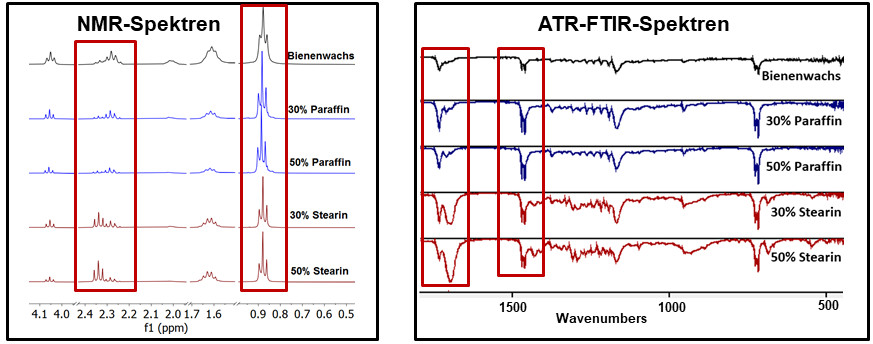Beeswax
Beeswax is a natural product that is produced by special wax-secreting glands of bee workers to build their comb. As a valuable raw material it is used in candle, pharmaceutical, cosmetic and food industries (E901) as well as essential raw material for the production of honeycombs. Despite of over 300 different single components, natural wax is mainly made of esters (70-80%), fatty acids (18-23%), alcohols (1%) and hydrocarbons (14%).1,2 Mandatory thresholds for yellow beeswax Cera flava3 and white beeswax Cera alba4 for appearance, odor, solubility, drop point, acid value, ester value and saponification number are listed in the European Pharmacopoeia (Ph. Eur.). However a specification for the total hydrocarbon content or thresholds for addition of paraffins or stearic acids do not exist in the European Pharmacopoeia. A maximum value of 18% for the total hydrocarbon content is only stated in the Quality Mark for candles (RAL-GZ041). According to the literature, natural beeswax contains about 14% hydrocarbons that make an addition of 4% paraffins possible. In general the production of beeswax in accordance to Ph. Eur. and E901 is allowed; even it contains paraffins and/or stearic acids. That might have dramatically consequences for the beekeeping. The intermixture of cheap stearic acid to beeswax can lead to higher larva mortality due to an increase in wax hardness. Addition of low melting paraffin can result in sagging or collapse of the honeycomb.
NMR- und ATR-FTIR-Analysis of beeswax
The addition of up to 10% of paraffins and stearic acids in beeswaxes can be detected by Nuclear Magnetic Resonance and Attenuated-Total-Reflection-Fourier-Transform-Infrared-Spectroscopy (NMR and ATR-FTIR). Paraffins can be detected by integration of the peaks at 0.9 ppm (CH3-Gruppen, NMR, see left spectrum of Picture 1) or by an increase of the CH2 scissor deformation by 1490cm−1 (ATR-FTIR). Stearic acid can be detected by the α-CH2 group of the acid (2.3 ppm, NMR) or by the stretching vibration of the carbonyl group at 1700cm−1 (ATR-FTIR).

Picture 1: NMR spectra (left) and ATR-FTIR spectra (right) of beeswax samples containing 30% and 50% paraffin and stearic acid each.
Please feel free to contact us if you have any questions about the analysis or in case you have special requirements.
Email: info.qsi@tentamus.com
Phone: +49 (0)421 / 59 66 070
Contact form
